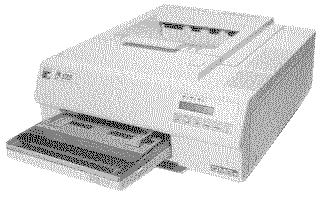 |
Language:
PCL Level 4, PostScript Speed: 8 PPM Memory: 6MB exp. to 8MB Graphics: 300, 600, HP-GL (Optional) Autorotate: Yes Duplex: Not Available RET: Not Available |
Fonts Per Page: 16* (Each attribute is a separate font)
Internal PCL Fonts
| Typeface | Size | Variation | Orientation | Symbol Set |
| Courier | 12 pt. (10 pitch) | Medium Upright | P & L | * |
| Bold Upright | P & L | * | ||
| Medium Italic | P & L | * | ||
| 10 pt. (12 pitch) | Medium Upright | P & L | * | |
| Bold Upright | P & L | * | ||
| Medium Italic | P & L | * | ||
| Line Printer | 8.5 pt. (16.67 pitch) | Medium Upright | P & L | * |
*All Fonts are available in Roman-8, PC-8, ECMA-94 PC-8 Danish/Norwegian, PC-850 and Legal. All of these can be used with ISO sets 2, 4 6, 10, 11, 14, 15, 16, 17, 21, 25, 57, 60, 61, 69, 84, 85, HP Spanish and HP German.
Internal Postscript Fonts
| Typeface | Size | Variation | Orientation | Symbol Set |
| Times-Roman | Scalable | Plain | P & L | |
| Scalable | Roman Italic | P & L | ||
| Scalable | Bold | P & L | ||
| Scalable | Bold Italic | P & L | ||
| Courier | Scalable | Plain | P & L | |
| Scalable | Bold | P & L | ||
| Scalable | Oblique | P & L | ||
| Scalable | Bold Oblique | P & L | ||
| Palatino | Scalable | Roman | P & L | |
| Scalable | Bold | P & L | ||
| Scalable | Italic | P & L | ||
| Scalable | Bold Italic | P & L | ||
| New Century Schoolbook | Scalable | Plain | P & L | |
| Scalable | Italic | P & L | ||
| Scalable | Bold | P & L | ||
| Scalable | Bold Italic | P & L | ||
| ITC Bookman | Scalable | Light | P & L | |
| Scalable | Light Italic | P & L | ||
| Scalable | Demi | P & L | ||
| Scalable | Demi Italic | P & L | ||
| ITC Zapf Chancery | Scalable | Medium Italic | P & L | |
| Adobe Garamond | Scalable | Plain | P & L | |
| Scalable | Italic | P & L | ||
| Scalable | Bold | P & L | ||
| Scalable | Bold Italic | P & L | ||
| Scalable | Semi | P & L | ||
| Scalable | Semi Bold Italic | P & L | ||
| Helvetica | Scalable | Plain | P & L | |
| Scalable | Bold | P & L | ||
| Scalable | Oblique | P & L | ||
| Scalable | Bold Oblique | P & L | ||
| Helvetica Condensed | Scalable | Plain | P & L | |
| Scalable | Bold | P & L | ||
| Scalable | Oblique | P & L | ||
| Scalable | Condensed Bold Oblique | P & L | ||
| Helvetica Narrow | Scalable | Plain | P & L | |
| Scalable | Bold | P & L | ||
| Scalable | Oblique | P & L | ||
| Scalable | Bold Oblique | P & L | ||
| ITC Avant Garde | Scalable | Book | P & L | |
| Scalable | Demi | P & L | ||
| Scalable | Book Oblique | P & L | ||
| Scalable | Demi Oblique | P & L | ||
| Symbol Set | Scalable | Plain | P & L | |
| ITC Zapf Dingbats | Scalable | Plain | P & L |
Continuous Feeding
Standard Tray: One 200-sheet letter/A4-size paper cassette
Optional Trays: Legal, Envelope and High Capacity cassette
1. Fill the cassette(s) with
paper. If you are using letterhead, be sure to place the paper
face up, top edge first.
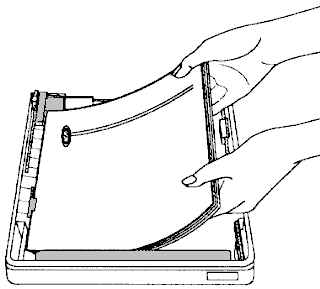
NOTE: The cassette label indicates which size paper to use. Each cassette sets off a series of internal switches when inserted in the printer which the printer reads to determine page size. Use only paper of the size on the cassette's label for cassette feed.
2. Place the cover on the cassette.
3. Slide the filled cassette
into the opening in the front of the printer. If you have the
dual cassette model, insert a filled cassette into both openings
in the front of the printer.
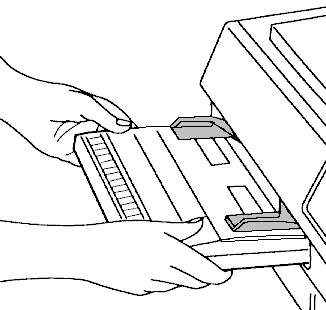
Manual Feeding
1. Set the paper guides on top of the cassette to the size paper you are using. The paper guides on the dual tray model are on the upper cassette.
2. Feed the sheet of paper
between the paper guides face-up, top edge first.
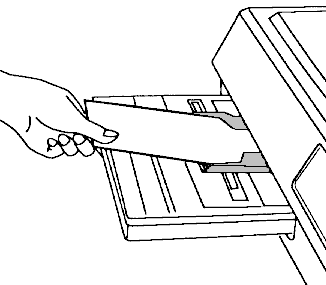
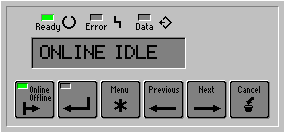
Control Panel Messages
Many printer problems are easiest solved by the control panel. When the printer needs operator assistance the message window displays one of the following:
PAPER OUT Paper tray is empty (single tray). The messages on the
dual tray printer say either the upper or lower cassette
is empty.
TONER LOW Displays to indicate low toner.
NO TONER Displays when no toner cartridge is installed.
CART
PAPER JAM Operator must clear paper jam.
PRINTER Close the printer top.
OPEN
MANUAL Printer is in manual feed and waiting for you to insert
FEED a sheet.
NO PAPER The paper cassette is either not in or not firmly seated.
TRAY
Service Messages
When the printer requires service, operation stops and the message window displays one of the following:
SCANNER Call for service.
ERROR
BEAM Call for service.
DETECT
ERROR
FUSER Call for service.
ERROR
NOTE: A service message sometimes occurs as a result of an unusual combination of events, not because of an actual problem. When the printer stops and a service message displays in the message window, cycle the printer off and back on. This often clears the service message indicator and printer operation resumes. Always try this before making a service call.
Service calls should be placed to the vendor from who you purchased the printer. If you cannot get service from your vendor, see Appendix D.
ESP Conflicts
Some applications do not provide command sequences at the beginning of a file, but send only text as their default mode. ESP conflicts may occur in such cases. If this happens, your printer prints the file in HP PCL since this is the least intricate of all the languages resident. If you wish to have the ESP mode default to another language you may do so from the control panel. Enter the menu and choose the main menu group, Emulation Setup. Go to the sub-menu ESP DEFAULT and choose PostScript.
Some applications and interface configurations require changing the emulation wait time-out to adjust the time required between files. If you use two interface ports and send an HP PCL file and PostScript file simultaneously or less than 5 seconds apart, there may be a conflict. The simplest way to adjust the emulation wait time-out is from the printer control panel. Go to the main menu group, Miscellaneous Options, and increase the ESP time-out.
In PS Executive, use the Options category, Default Time-outs selection, and increase the set emulation wait time-out.
NOTE: Microsoft Windows is particularly sensitive to the
emulation wait time-out.
Separate Files Print as One
In emulation, you should not concatenate files. Concatenate means to merge several independent data sets, or jobs, to create one large data set. This can be done inadvertently (especially from the DOS print or copy command) by sending files rapidly in succession. Wait at least five seconds before sending another job or make sure files are separated with a form feed at the end of the file.
If you are on a network and one queue is set up to hold both PostScript and HP files, you should add a trailer to the end of each file sent. This trailer could be simply a ^D (ASCII 04) for a PostScript file or, for an HP PCL file, an <ESC>< DEL>< O> and the appropriate command to change the interface back to ESP. (See the chapter "Technical Reference" Communication" for these commands. The files to accomplish this are also included in the PS Executive Series software.) ESP works by sampling a small part of data at the beginning of a file. From this sample, it chooses the proper printer language. When the printer sends an HP file from the queue, then rapidly sends a PostScript, a plain printout of a PostScript program may print, rather than the graphic it should have translated and printed. This occurs because HP files do not have end-of-file markers and the printer is not signaled that a new file has begun.
Printer Problem Checklist
This section contains a list of possible printer problems and solutions. If you have just installed your printer, be sure you have followed the steps outlined in the Getting Started Guide.
If there is no display message, follow the steps below to identify the source of your problem and to learn about possible solutions. Many problems can be corrected by going through the steps on this list.
1. Does the printer power light come on?
YES - Go to number 2.
NO - Check the following:
Is the power cord plugged into both the power outlet and
the printer?
Does the line voltage from the power outlet match the printer's power requirements? See Appendix B.
2. Can you print a status page?
YES - Go to question 3.
NO - Check the following:
Is the printer off-line before you try to enter the menu? It should be.
Does the cassette have paper? If it is out of paper, the Paper Out message displays and the error indicator lights.
Is the method of tray delivery configured correctly (QMS PS-825 only)? See the chapter, "Printing."
Is the printer top closed securely?
Is there a paper jam? If the Paper Jam message displays and the error indicator lights, go to the following section, "Paper Jams."
3. Is the printer receiving data from the computer? Check the status of the Data indicator. If it blinks after sending the file, the printer is receiving the data.
Is the printer on-line? The message window should display ON-LINE IDLE.
Has the communication mode been changed from ESP to a dedicated mode that does not match the file you are sending. See the chapter "Printing" or the chapter "Technical Reference: Communication."
Print a status page from the control panel. If you are using the serial interface, is the baud rate (speed of data transmission) of the printer, the computer, and your software application program the same? See the chapter, "Technical Reference: Communication."
If you still cannot identify the problem, contact your QMS vendor.
4. Is the printer printing garbage or not printing at all when in ESP mode?
Reconfigure the port to the specific printer language of the file you are trying to print. See the chapter "Printing" for instructions or use the PS Executive Series Utilities to change modes.
If a PostScript file prints PostScript language statements while in ESP mode, increase the ESP time-out See the chapter "Printer Control" to change from the control panel, or increase the time-out with the PS Executive Series utility.
If you continue to have problems with the ESP mode selecting printer language, contact your QMS vendor.
5. If nothing prints at all, do an engine test print. On the lower right side of the printer is an access panel marked "Test Print." Insert a pen or pencil into the circle opening. This should produce a page with vertical lines from one end to the other. If the test print shows any pattern other than this, contact your QMS vendor.
UNIX Users
If you are printing through the serial interface from a UNIX host, is the getty disabled? What does the printcap say?
Data Light Stays Lit
After warming up, if the Data indicator stays on, two problems may exist. If you are downloading additional typefaces, too many can overload the printer's memory. If you're on an AppleTalk printer network, Macintoshes may sometimes interfere with each other. If this happens often, re-install the LaserWriter and Laser Prep files. This causes the printer to reset. If this is not the case, place a service call to your QMS vendor.
No Start-up Page
If the Ready indicator is on, but no start-up page prints, check the following:
is the start-up page print process turned off?. Check the status through the control panel under the Miscellaneous Options menu. If the start-up page is not turned off, do the following:
2. Turn the printer off. From a cold start, it takes a minute for the printer to warm up. Be sure you wait long enough for a start-up page before suspecting a problem.
3 . Check to be sure the paper cassette(s) is in place and secure.
4. Open the top section of the printer and check for a paper jam.
5. Make sure a toner cartridge is installed.
If none of the above problems are found, call your QMS vendor. Before calling, open the printer and lift the green fixing assembly cover in the front. Hold your hand just close enough to tell whether the rollers are hot. Your QMS vendor will need this information.
Clearing a Paper Jam
When a paper jam occurs, the Paper Jam message displays in the message window. Frequent jams in any area indicate that the area should be checked and repaired or cleaned. Repeated jams may also signal you are using the wrong weight paper.
NOTE: Before clearing a paper jam, wait for your computer to give a message that the printer has jammed. If an attempt is made to clear the condition before the message is received by the computer, a page may be lost.
Clear paper jams as follows:
1. Open the printer top section and locate the jammed paper. Be careful, the area around the transfer guide and roller will be hot.
2. Open the transfer paper guide lock and remove any paper (fig. 5.1).
3. Pull out any paper stuck under the transfer guide (fig. 5.2).
4. If paper is stuck in the toner fuser, carefully pull the paper out (fig. 5.3). The paper will be hot and the toner may still be powdery.
5. If paper jams upon entry from either paper cassette, simply pull the sheet of paper back toward you to clear the jam. Even though the jam is cleared without opening the printer's top, you must still open and reclose the top to reset the printer.
Printer Resets
1. Occasionally, software packages interfere with each other. Macintosh applications have a header file sent to the printer at the beginning of each document. This file alters the state of the printer. Other header files cannot be sent without resetting the printer. Monitor your activities to see if there is a correlation between your use of a certain software package and the printer resetting. If so, contact the software package developer.
2. If you are downloading additional typefaces, too many can overload the printer's memory and cause the printer to reset to default. Additional memory (RAM) is available and easily installed. Contact your QMS vendor for information on RAM upgrade modules. See the chapter, "Optional Printer Accessories."
3. If the printer resets in other circumstances, you should call your QMS vendor for service.
Blank Pages
1. If the start-up page ejects on start-up, but it is blank, or blank pages are output from the printer during a printing job, check the toner cartridge. Pages will not print if the toner cartridge is empty.
2. Be sure you have broken the tab on the side of the toner cartridge and removed the sealing tape.
3. If the toner cartridge is not empty, the sealing tape has been removed, and blank pages are ejecting, take the cartridge out and roll it from side to side.
4. If these solutions do not work, contact your QMS vendor to purchase another toner cartridge.
Not All Pages Print
1. Check your cable. You should have a null modem for PC's and AppleTalk network and connector boxes for a Macintosh. See the chapters in this manual on connecting and testing either a Macintosh or an IBM PC. You could have the wrong kind of cable.
2. If you have an IBM PC/compatible and use a serial cable, you may have a protocol conflict (flow control). If you are using the default DTR/DSR, try the XON/XOFF protocol. See the chapter, "Technical Reference: Communication" to change the flow control. (Protocol is listed on the start-up page.)
3. If you have a Macintosh, a problem on the AppleTalk network may be the cause. Turn the printer off, wait 10 seconds, and turn it back on. If it prints a start-up page (as it should unless you've turned that function off), the problem is probably fixed.
On an AppleTalk network, another user may be sending either a LaserPrep or Print Monitor file that is not the same version as the one in your System Folder. All users on an AppleTalk network should have the same versions of these files.
4. If you are on a network, check the print queue to see if your file made it to the queue and is still there.
Paper Jam Message Stays On
If the Paper Jam message stays on, open the printer and clear the jam. If the message is still there, try opening and closing the top of the printer again. See the previous section, "Clearing a Paper Jam," for more information.
IBM PC/Compatible Checklist
PC users check the following:
Does your software setup match the settings that appear on the lower half of the start-up page?
Have you set up your printer port on the system level (DOS) and installed a PostScript driver within your application program? (See DOS and software documentation.)
RS-232C serial users may have a protocol conflict. Set the printer to XON/XOFF protocol. If that doesn't work, try DTR/DSR. See "Technical Reference: Communication."
Check the manual that came with your software program to ascertain whether the program is PostScript compatible.
For RS-232C serial port users: from the DOS screen, type the mode commands to activate the serial port Send a simple Print Screen. #' If this produces a page, it means that your serial port, cable, and the printer are working.
If you get a printout, then your application program is configured incorrectly. Make sure you have installed the correct printer driver and have told the software what port you are using.
Macintosh Users Checklist
Macintosh users should check the following:
Are the printer and computer properly connected?
Does the Chooser show the LaserWriter printer icon? If not, check the next step.
Are Laser Writer, Laser Prep, and PrintMonitor files installed in your system folder?
Is the printer turned on?
Have you selected LaserWriter in the Chooser and highlighted the printer name?
Is AppleTalk active?
Is AppleTalk properly terminated?
If you are on a network, check the LocalTalk cable system and the LocalTalk owner's guide. Someone on the network may have changed the name of your printer. Print a status page from the printer's control panel, or turn the printer off then back on to produce a start-up page. This shows the printer's name.
Parallel
Availability: Standard
Connection: High-speed parallel
Activation: Simultaneous Interface Operation (SIO) - Allows all three interfaces to be attached to host computers at the same time and receive data simultaneously
Serial
Availability: Standard
Connection: RS-232-C serial
Activation: Simultaneous Interface Operation (SIO) - Allows all three interfaces to be attached to host computers at the same time and receive data simultaneously
AppleTalk
Availability: Standard
Connection: 9 pin AppleTalk/LocalTalk
Activation: Simultaneous Interface Operation (SIO) - Allows all three interfaces to be attached to host computers at the same time and receive data simultaneously